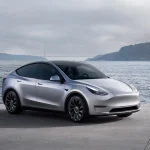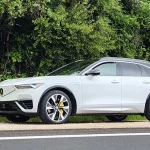
Hey, media, get it straight: “electrified” is NOT “electric,” and the difference mattersHey, media, get it straight: “electrified” is NOT “electric,” and the difference matters
OK, reporters of the world, it’s time for a little chat.
We know—believe me, we know—that you are cranking out a whole lot of copy, with much less support than you used to have, on far tighter deadlines, to feed a voracious, anonymous online audience whose clicks get you paid.
But it’s time to discuss the very, very important difference between two similar words that have gotten you in a world of hurt lately.
DON’T MISS: Volvo to electrify all cars from 2019: ‘end of internal-combustion engine alone’
Those two words are “electrified” and “electric.”
You might think they’re pretty similar, right? Both something to do with electricity. And in stories you’ve written this year, those electric cars everyone’s talking about. Right?
Yes. But no.
Volvo CMA modular compact car platform in electric configuration
Applied to cars, the difference is absolutely crucial—and worth billions of dollars to the industry at large.
“Electric” cars are vehicles that plug into the electric grid to recharge batteries that provide the energy to run them.
But “electrified” cars simply have an electric motor somewhere in the drivetrain—and they don’t necessarily have plugs (although they may).
READ THIS: Ford plans 300-mile electric SUV, hybrid F-150 and Mustang, more U.S. production (Jan 2017)
The first category, electric cars, includes battery-electric cars (e.g. Nissan Leaf, Tesla Model S) and also plug-in hybrid vehicles (e.g. Chevrolet Volt, Toyota Prius Prime).
But the second category, electrified cars, is much bigger.
It includes not only both kinds of electric cars, but also conventional hybrids (which have no plug, and run all-electric for only a mile or so under light power), plus what are called mild hybrids—which are enhanced start-stop systems.
2012 Toyota Prius Plug-In Hybrid – production model
Every vehicle in that group has one or two electric motors in its drivetrain, somewhere, but they vary a lot in size.
The motors in those mild hybrids can’t move the car by itself; it just helps the engine a bit, improving efficiency by feeding recaptured energy back into the wheels that would otherwise have been wasted.
Today, most electrified vehicles are much, much cheaper to build than electric cars with their large battery packs.
CHECK OUT: 48-volt mild hybrid systems: what they do, how they change the car
Which is why you need to understand the difference between the two words when a car company makes a big announcement about future products and you hear what you think is the word “electric” somewhere in the press release.
Consider the Volvo announcement that got so much traction this week.
Many, many news outlets reported that Volvo will make only electric or hybrid cars from 2019 on, which is not what the company said.
2016 Volvo XC90 T8 Twin Engine plug-in hybrid
Volvo used the word “electrified,” which many reports assumed meant electric. It didn’t.
(1) Volvo said new models starting in 2019 would be plug-in hybrid or battery electric vehicles, or have a 48-volt mild-hybrid system (which means without a plug) available.
(2) The latter group will likely be, at least initially, the largest group of the three.
(3) The announcement only affects new models from 2019, so Volvo will keep existing vehicles now using gasoline or diesel engines in production for … well, several years to come yet.
In other words, Volvo will ensure that all of the cars it launches—starting two years from now—are capable of accepting enhanced start-stop hardware, aka 48-volt mild hybrids.
Bosch 48-volt mild hybrid
It will also likely raise the proportion of plug-in hybrids if buyer demand proves to exist, and launch its first all-electric vehicle, which had been previously reported.
Ford, by the way, got similar positive PR for its supposed plans to release “13 electric cars” by 2020.
In fact, it used the word “electrified”: one or perhaps two of those will be all-electric, some will be plug-in hybrid, and the majority will be conventional hybrids of the sort Ford has built since 2004.
It will add a hybrid F-150 as well, but that’s hardly an “electric car.”
See the difference?
_______________________________________
Follow GreenCarReports on Facebook and Twitter.
View original article at: “https://www.greencarreports.com//news/1111413_hey-media-get-it-straight-electrified-is-not-electric-and-the-difference-matters”
Add a comment Cancel reply
Comments (0)
check out this site
… [Trackback]
[…] There you will find 60113 more Info to that Topic: autoseu.com/hey-media-get-it-straight-electrified-is-not-electric-and-the-difference-mattershey-media-get-it-straight-electrified-is-not-electric-and-the-difference-matters/ […]
sig 320
… [Trackback]
[…] Information on that Topic: autoseu.com/hey-media-get-it-straight-electrified-is-not-electric-and-the-difference-mattershey-media-get-it-straight-electrified-is-not-electric-and-the-difference-matters/ […]
magna tiles
… [Trackback]
[…] Find More Information here to that Topic: autoseu.com/hey-media-get-it-straight-electrified-is-not-electric-and-the-difference-mattershey-media-get-it-straight-electrified-is-not-electric-and-the-difference-matters/ […]
Categories
- Activism (1)
- Adventure (1)
- Advertising (2)
- Agriculture (1)
- Air pollution (4)
- Air transport (3)
- aluminium (2)
- Amazon (3)
- Animals (1)
- Apple (2)
- Architecture (1)
- Arctic (1)
- Artificial intelligence (1)
- Augmented Reality (1)
- Auto Detailing (1)
- autopilot (1)
- battery (31)
- Best summer holiday destinations 2022 (1)
- Bicycle (1)
- biodiversity (1)
- BMW (2)
- boat (1)
- Bus (1)
- Business (4)
- Buying Guides (1)
- car (7)
- Car industry (18)
- Car News (18)
- car rental (3)
- Car Reviews (4)
- Car sales (6)
- carbon emissions (15)
- carbon footprint (3)
- Carlos Ghosn (1)
- Cars (66)
- Central Europe (1)
- CES (2)
- charging station (11)
- Children (1)
- China (12)
- Citroën (1)
- city (1)
- City transport network (2)
- clean energy (2)
- Climate (1)
- climate change (9)
- Climate crisis (4)
- Climate emergency (2)
- climate protection (2)
- CO2 emissions (39)
- Company (3)
- Competition (1)
- Conscious travel (2)
- Contamination of water (1)
- Copper (2)
- cost of living (2)
- Cuba (1)
- Cuban politics (1)
- Cybertruck (1)
- Cycling (1)
- deforestation (1)
- delivery (3)
- Denmark (2)
- Detroit (1)
- Diesel (4)
- Diesel car (7)
- e-mobility (11)
- e-scooter (2)
- Eco travel (3)
- Eco-friendly (2)
- Ecology (1)
- Economy (1)
- El Niño (1)
- Electric (11,302)
- Electric boats (1)
- electric car (107)
- Electric Cars (499)
- Electricity (5)
- Electricity consumption (3)
- Electricity market (5)
- Elon Musk (21)
- emission (1)
- Emmanuel Macron (1)
- Energy (2)
- Energy low cost (1)
- energy transition (6)
- Entrepreneur (1)
- Environment (5)
- Environment pollution (1)
- Environmental protection (4)
- EU Policy (1)
- EU-China (2)
- Europe (7)
- Europe's energy crisis (1)
- European Commission (3)
- European economy (2)
- European Union (18)
- Euroviews (6)
- Eviction (1)
- EVs (37)
- F1 (1)
- factory (4)
- fake news (1)
- family (2)
- Ferrari (1)
- fertilizer (1)
- fine (penalty) (1)
- fire station service (1)
- flight (1)
- Flying car (4)
- Food security (1)
- Ford (1)
- Formula 1 (2)
- Fossil fuels (14)
- France (39)
- free trade (1)
- Fuel (3)
- Fuel cell electric vehicles FCEV (10)
- fuel crisis (2)
- Fuel Efficiency (3)
- fuel prices (1)
- Funeral (1)
- Gas (1)
- Gas Prices (1)
- gasoline price hike (1)
- German (1)
- Germany (8)
- Giorgia Meloni (1)
- Global warming and climate change (1)
- Good News (1)
- Greece (1)
- green energy (1)
- green new deal (1)
- Green transportation (17)
- Green Week (1)
- greenhouse gas emissions (6)
- Hanoi (19)
- Health (1)
- home (2)
- homelessness (1)
- Housing market (19)
- human rights abuse (1)
- Hybrid (2,283)
- Hybrids (116)
- Hydrogen (2)
- hydrogen vehicle (2)
- IAA Mobility (2)
- Iceland (3)
- incident (1)
- income (1)
- India (2)
- Indonesia (1)
- infrastructure (1)
- innovation (1)
- International relations (1)
- Investment (4)
- iPhone (1)
- Japan (1)
- Jobs (3)
- Joe Biden (4)
- Jubilee (1)
- Lampedusa (1)
- Las Vegas (1)
- lead petrol (2)
- Lithium (13)
- liveable cities (2)
- London (3)
- Luxembourg (1)
- Luxury (2)
- luxury goods (2)
- Luxury lifestyle (2)
- Manufacturing (5)
- Market (1)
- Markets (1)
- meat (1)
- Mercedes-Benz (39)
- Migrants (1)
- minerals (2)
- Mining (5)
- Mitsubishi Motors (1)
- Mobile World Congress (1)
- Mobility (10)
- Mobility Week (2)
- Mobility Week 2021 (1)
- Mobility Week 2023 (5)
- money (3)
- Motorcycling (2)
- Motorsport (1)
- Mountain (1)
- NASA (1)
- nature (2)
- net-zero (2)
- New technologies (6)
- Next Explainers (1)
- Next In data (2)
- Nigeria (1)
- Nissan (3)
- Norway (7)
- Nuclear Energy (1)
- nuclear fusion (1)
- Nuclear power plant (1)
- Odd (1)
- oil industry (1)
- Olaf Scholz (1)
- online shopping (1)
- Oslo (1)
- Paris (1)
- parody (1)
- Petroleum products (3)
- Peugeot (1)
- plastic (1)
- Poland (1)
- Politics (1)
- Pollution (44)
- Power Plant (1)
- prices (1)
- production (1)
- Profits (1)
- Prostitution (1)
- Public transport (4)
- Racing cars (1)
- Racism (1)
- Rail transport (2)
- rats (1)
- Raw material (1)
- Recycling (4)
- Renault (3)
- Renewable energies (6)
- renewable energy (6)
- Reykjavík (1)
- Rishi Sunak (1)
- road (36)
- Road infrastructures (1)
- Road safety (7)
- Road transport (20)
- road trip (1)
- Robot (1)
- Rolls Royce (1)
- Russia (1)
- Russia's invasion of Ukraine (2)
- Sadiq Khan (1)
- safari (1)
- Safety (1)
- Sale (1)
- sales (3)
- Scotland (1)
- self-driving (43)
- Semiconductor (1)
- Shares (1)
- Show (1)
- Silicone (1)
- Software (1)
- Solar energy (2)
- solar power (5)
- Space technology (1)
- Spain (1)
- start-up (3)
- Stock exchange transaction (1)
- Stock market activity (1)
- Stockholm (1)
- Strasbourg (1)
- Students (1)
- Summer Olympics (2)
- Sustainability (7)
- Sustainable city (3)
- Sustainable design (3)
- Sustainable development (1)
- Sustainable innovation (9)
- Sustainable technology (21)
- Sustainable tourism (4)
- Sweden (2)
- Tata Motors (2)
- Tax (37)
- Taxes (2)
- Taxi (1)
- Technology (55)
- Tesla (73)
- The Boring company (1)
- Tokyo Olympic Games 2020 (1)
- Toyota (4)
- trade (3)
- traffic (1)
- Trains (2)
- Transport (11)
- transportation (3)
- Travel destinations (1)
- Tunnel (1)
- Twitter (3)
- UBER (1)
- Ukraine war (1)
- Uncategorized (6)
- United Kingdom (5)
- United States (6)
- urban planning (2)
- Ursula von der Leyen (3)
- US politics (1)
- USA (1)
- vegan (1)
- vehicle (7)
- Video (4)
- Vietnam (19)
- Volkswagen (3)
- Volvo (2)
- waste (1)
- waste disposal (1)
- Water (1)
- Water resources (1)
- White House (1)
- wind energy (1)
- Wind turbine (1)
- Winter (2)
- work conditions (1)
- World Travel Market (1)
- Xiaomi (1)
Recent Posts
About us

Popular Tags
Related posts


Volvo EX30 in the test: Really a premium car at a volume price?

VW ID.7: Estate is not called Variant... It's a Tourer







